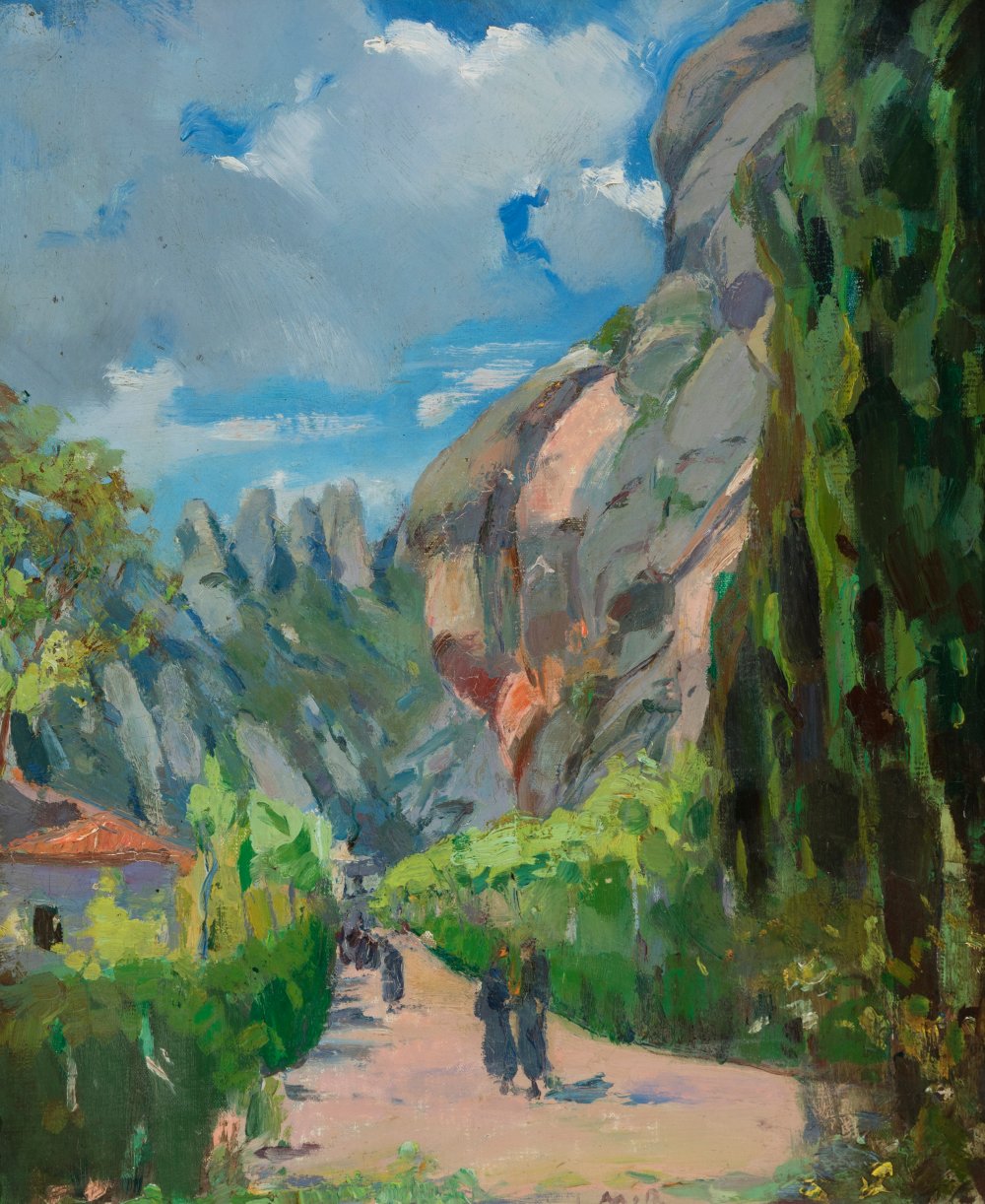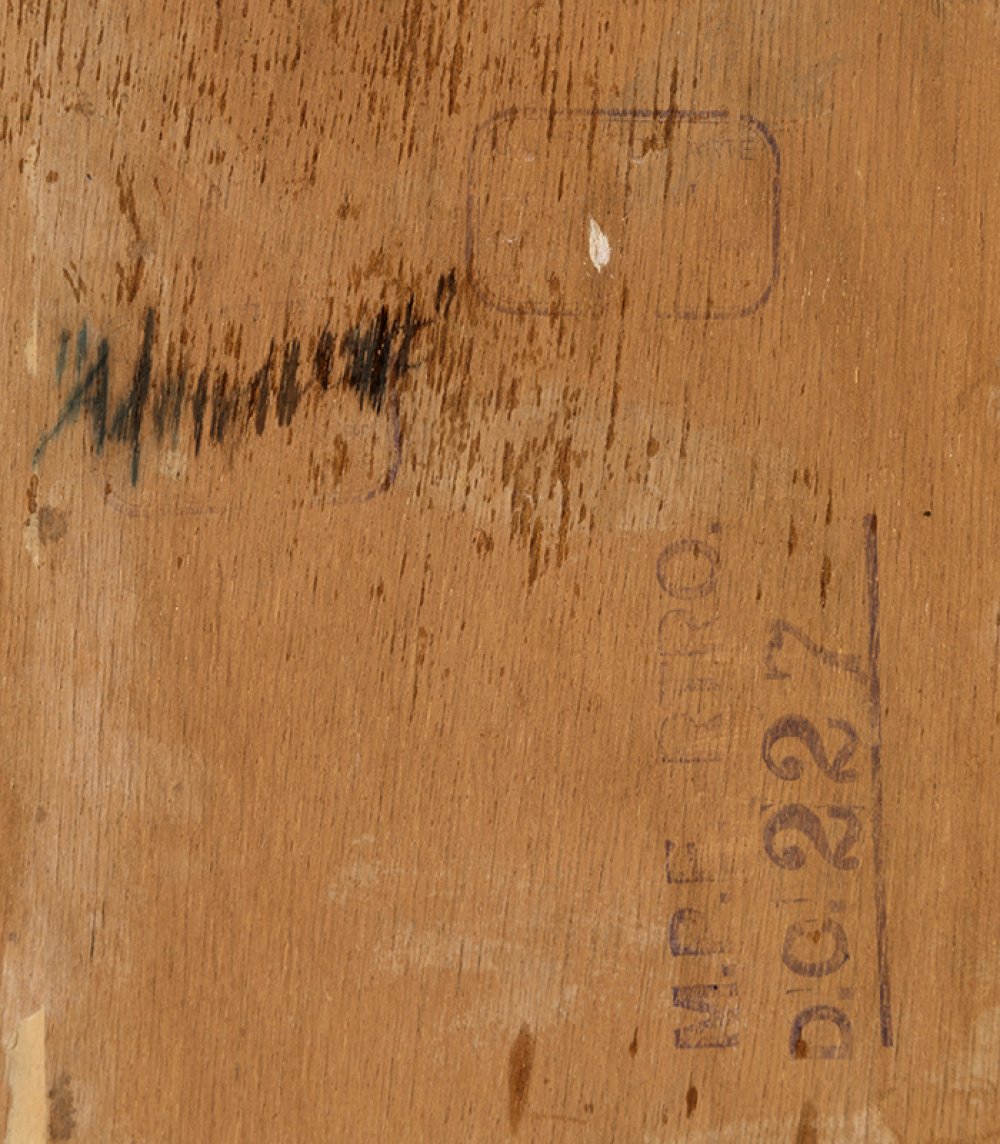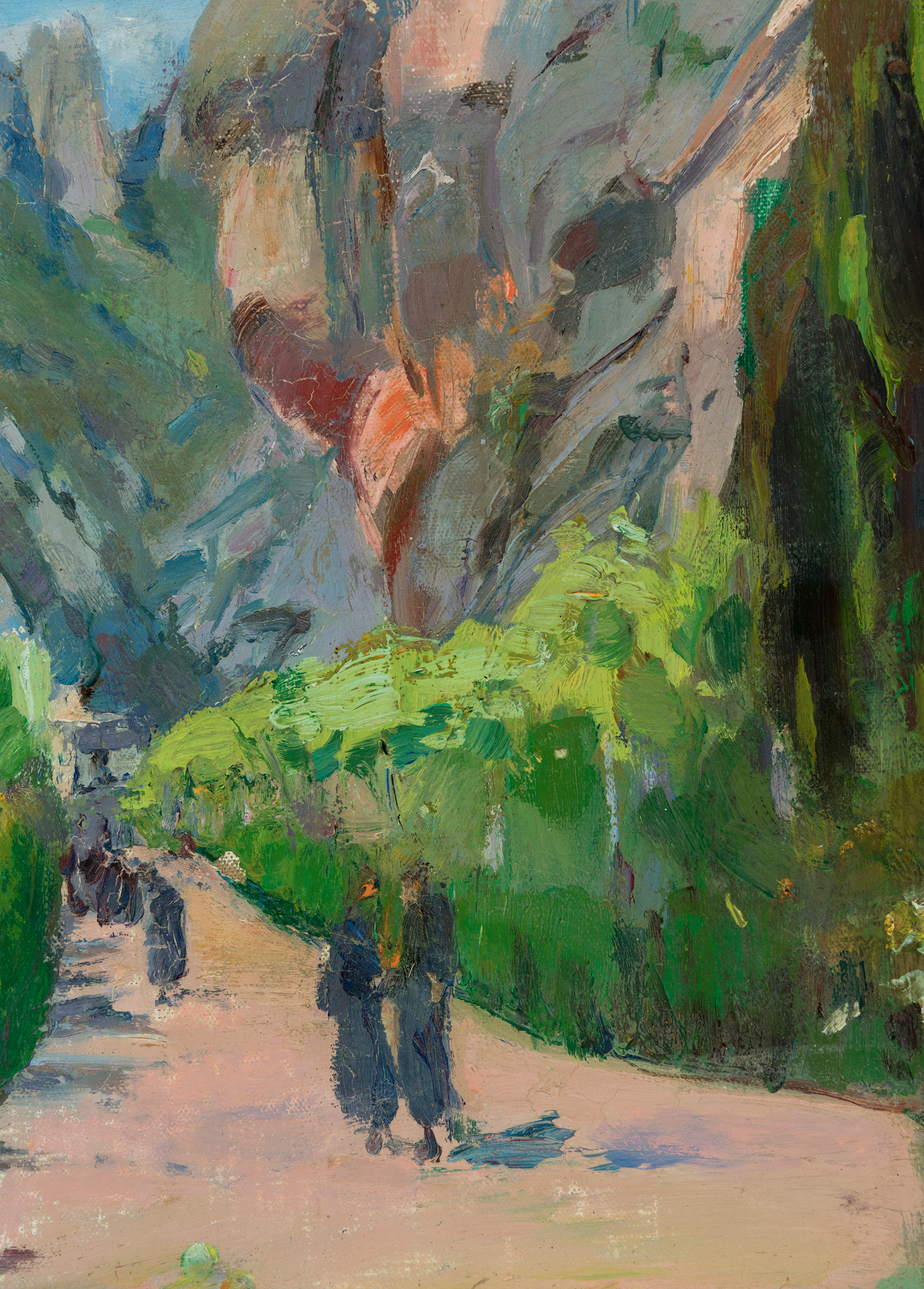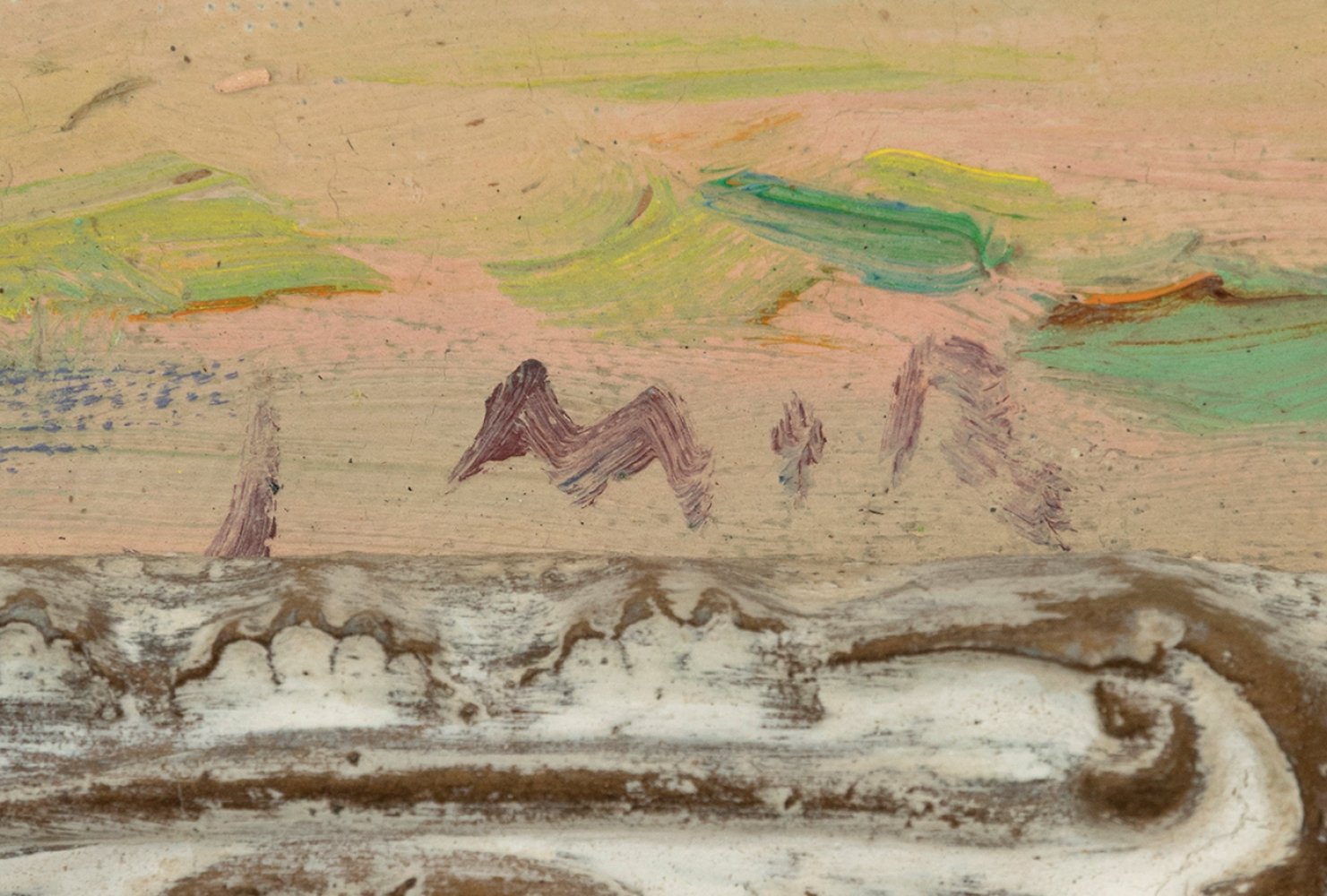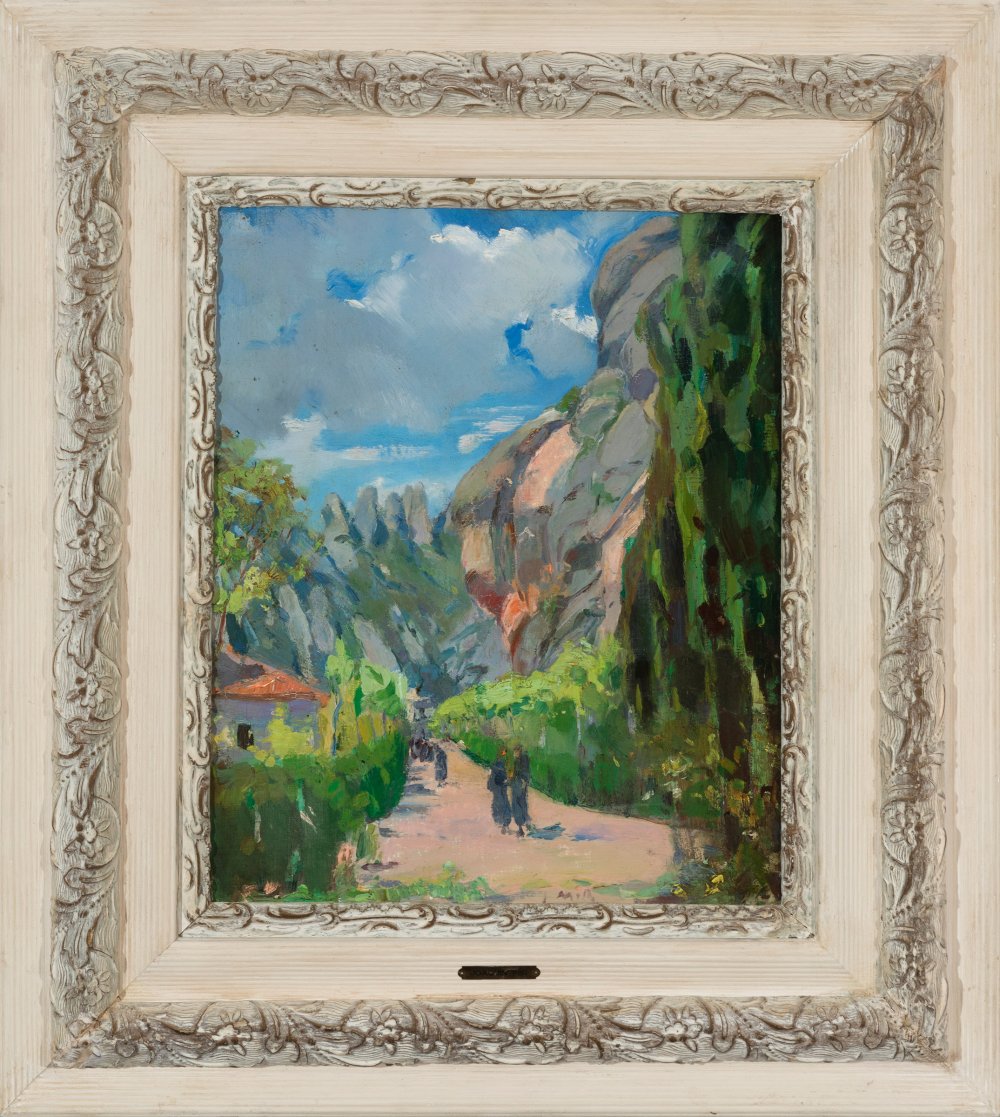55
JOAQUIN MIR TRINXET (Barcelona, 1873 - 1940)."Landscape of Montserrat".Oil on canvas glued to
"Landscape of Montserrat".
Oil on canvas glued to panel.
Signed in the lower central area.
Size: 45,5 x 38 cm; 71 x 64 cm (frame).
In this work Mir demonstrates his absolute mastery of the technique and of the capture of the landscape, in an image in which he manages to synthesize the naturalistic representation, the personal expression and the pictorial order. We see a sensitive brushstroke, which explores the space and gives it form and entity, creating volumes, lights and shadows, defining an atmosphere captured with great sensitivity. Through a purely personal language, Mir synthesises the basic elements of representation and expressiveness of painting, as can be seen in the intensity of his colours and the particularity of his compositional structure.
Joaquín Mir studied at the San Jordi School of Fine Arts in Barcelona and in the studio of the painter Luis Graner. His style was also influenced by the School of Olot, his father's city of origin. He soon felt uncomfortable with the official teaching, which was anchored in a conception of realist painting, and so in 1893 he founded the "Colla del Safrà" with other colleagues (Nonell, Canals, Pichot, Vallmitjana and Gual) to explore together the pictorial initiatives of the end of the century. In 1896 they even participated as a group in the 3rd Exhibition of Fine Arts and Artistic Industries, to which Mir presented two works that give us a clear idea of the group's ideals: "La huerta del rector" ("The Rector's Vegetable Garden") and "El vendedor de naranjas" ("The Orange Seller"). Also, from 1897 he frequented the artistic environment of "Els Quatre Gats", where all the artists who were familiar with the European avant-garde gathered, which helped him to mature in the compositional study of landscapes with figures in different planes of depth. From this period are "Slopes of Montjuic" (1897) and "The Cathedral of the Poor" (1898), the two masterpieces of his youth. During these years he took part in the Fine Arts Exhibitions in Barcelona in 1894, 1896 and 1898. Winner of a second medal at the Madrid Exhibition of 1899, that same year he moved to the capital with the aim of applying for a scholarship in Rome. When he was unsuccessful, he went with Santiago Rusiñol to Mallorca, a trip that was to be a definitive turning point in his career. Mir was dazzled by the Mallorcan landscape, particularly that of Sa Calobra, which was an inexhaustible source of inspiration for him. From then on the artist deployed a whole combination of impossible colours, the result of his personal interpretation of the island's majestic nature. The brushstrokes grew longer and became stains that almost made objects and spatial references disappear. In 1901 he exhibited the fruit of this first Mallorcan period in a solo exhibition at the Sala Parés in Barcelona, and again won a second medal at the National Exhibition. After a period of illness that forced him to move to Reus, in 1907 he won the first medal at the International Exhibition of Fine Arts in Barcelona. From then on, settled in Camp de Tarragona, he did not move away from the landscape genre, but now it was the villages of the surrounding area that were the protagonists of his painting. Already established as a leading figure on the Catalan scene, he gained definitive national recognition in 1917, when he was awarded the National Prize for Fine Arts. Four years later he married and settled permanently in Vilanova i la Geltrú. His successes followed one after the other, and in 1929 he won the first medal at the International Exhibition in Barcelona. The following year he won the medal of honour at the National Exhibition in Madrid, a prize he had been after since 1922. Although he was mainly a native painter, he held solo and group exhibitions in Washington, Paris, Pittsburgh, New York, Philadelphia, Amsterdam, Buenos Aires and Venice. Mir is today considered the foremost representative of landscape painting.
"Landscape of Montserrat".
Oil on canvas glued to panel.
Signed in the lower central area.
Size: 45,5 x 38 cm; 71 x 64 cm (frame).
In this work Mir demonstrates his absolute mastery of the technique and of the capture of the landscape, in an image in which he manages to synthesize the naturalistic representation, the personal expression and the pictorial order. We see a sensitive brushstroke, which explores the space and gives it form and entity, creating volumes, lights and shadows, defining an atmosphere captured with great sensitivity. Through a purely personal language, Mir synthesises the basic elements of representation and expressiveness of painting, as can be seen in the intensity of his colours and the particularity of his compositional structure.
Joaquín Mir studied at the San Jordi School of Fine Arts in Barcelona and in the studio of the painter Luis Graner. His style was also influenced by the School of Olot, his father's city of origin. He soon felt uncomfortable with the official teaching, which was anchored in a conception of realist painting, and so in 1893 he founded the "Colla del Safrà" with other colleagues (Nonell, Canals, Pichot, Vallmitjana and Gual) to explore together the pictorial initiatives of the end of the century. In 1896 they even participated as a group in the 3rd Exhibition of Fine Arts and Artistic Industries, to which Mir presented two works that give us a clear idea of the group's ideals: "La huerta del rector" ("The Rector's Vegetable Garden") and "El vendedor de naranjas" ("The Orange Seller"). Also, from 1897 he frequented the artistic environment of "Els Quatre Gats", where all the artists who were familiar with the European avant-garde gathered, which helped him to mature in the compositional study of landscapes with figures in different planes of depth. From this period are "Slopes of Montjuic" (1897) and "The Cathedral of the Poor" (1898), the two masterpieces of his youth. During these years he took part in the Fine Arts Exhibitions in Barcelona in 1894, 1896 and 1898. Winner of a second medal at the Madrid Exhibition of 1899, that same year he moved to the capital with the aim of applying for a scholarship in Rome. When he was unsuccessful, he went with Santiago Rusiñol to Mallorca, a trip that was to be a definitive turning point in his career. Mir was dazzled by the Mallorcan landscape, particularly that of Sa Calobra, which was an inexhaustible source of inspiration for him. From then on the artist deployed a whole combination of impossible colours, the result of his personal interpretation of the island's majestic nature. The brushstrokes grew longer and became stains that almost made objects and spatial references disappear. In 1901 he exhibited the fruit of this first Mallorcan period in a solo exhibition at the Sala Parés in Barcelona, and again won a second medal at the National Exhibition. After a period of illness that forced him to move to Reus, in 1907 he won the first medal at the International Exhibition of Fine Arts in Barcelona. From then on, settled in Camp de Tarragona, he did not move away from the landscape genre, but now it was the villages of the surrounding area that were the protagonists of his painting. Already established as a leading figure on the Catalan scene, he gained definitive national recognition in 1917, when he was awarded the National Prize for Fine Arts. Four years later he married and settled permanently in Vilanova i la Geltrú. His successes followed one after the other, and in 1929 he won the first medal at the International Exhibition in Barcelona. The following year he won the medal of honour at the National Exhibition in Madrid, a prize he had been after since 1922. Although he was mainly a native painter, he held solo and group exhibitions in Washington, Paris, Pittsburgh, New York, Philadelphia, Amsterdam, Buenos Aires and Venice. Mir is today considered the foremost representative of landscape painting.
19th October - 19th & 20th Century Art
Sale Date(s)
Venue Address
General delivery information available from the auctioneer
Setdart offers Worldwide shipping
PICK UP IN ROOM: You can come and pick up your lots in our offices (Barcelona, Madrid or Valencia). At the moment of the withdrawal, you will be able to accept the current conditions of the lot by means of a document that you will sign.
YOU CAN SEND ANOTHER PERSON TO PICK UP: This person must present a signed authorization that you can find in our web page by accessing from BUY AT SETDART- LOGISTICS-DOWNLOAD AUTHORIZATION DOCUMENT. You can also send an e-mail with the requested data in AUTHORIZATION DOCUMENT to admin@setdart.com
Important Information
25% buyer´s premium
21% buyer´s premium at www.setdart.com
Terms & Conditions
The maximum period to pay the lots is 7 working days. You can pay either via bank transfer or with credit card through our platform www.setdart.com (we only accept VISA or Mastercard).
BUYER´S PREMIUM: 22% Hammer price + 21% VAT from the buyer´s premium
If your piece has more than 100 years, our Ministry of Culture requires an export certificate in order for the piece to leave the country. Note that if the piece goes inside the EU, there is no cost for the export certificate. If the piece goes outside the EU, there is a cost for the export certificate. You can find more information in our Ministry of Culture website: https://www.culturaydeporte.gob.es/en/cultura/patrimonio/exportacionimportacion/exportacion/tasas.html
INQUIRIES: admin@setdart.com
Setdart guides you through the entire process, from the time of award to the day you receive your lot. Our logistics team will be happy to manage your transport, and will advise you on the best shipping method with professionals from the sector used to handling works of art and jewelry.
WE OFFER WORLDWIDE DOOR TO DOOR SHIPPING
PICK UP IN ROOM: You can come and pick up your lots in our offices. At the moment of the withdrawal, you will be able to accept the current conditions of the lot by means of a document that you will sign.
YOU CAN SEND ANOTHER PERSON TO PICK UP: This person must present a signed authorization that you can find in our web page by accessing from BUY AT SETDART-LOGISTICS-DOWNLOAD AUTHORIZATION DOCUMENT. You can also send an e-mail with the requested data in AUTHORIZATION DOCUMENT to admin@setdart.com
SETDART IS NOT RESPONSIBLE FOR THE STATE OF THE PARTS ONCE THEY LEAVE OUR FACILITIES. MRW SHIPMENTS: Once the payment is made, your lot will be packed for shipment, the logistics department will send you an e-mail notifying you of the day it leaves our warehouse, changes of address cannot be made after receiving this e-mail.
INSURANCE INCIDENTS: Coverage for the value of the auction up to 3000 ? per shipment, if the value of the auction is higher, Setdart will send you a quote including the additional insurance. The insurance company WILL NOT BE RESPONSIBLE FOR THE SHIPMENT THAT EXCEEDS THAT AMOUNT AND IS NOT FULLY INSURED. MRW INCIDENTS: Maximum notification 48 hours after receipt, after which the insurance company WILL NOT BE RESPONSIBLE AND NO CLAIMS WILL BE ACCEPTED.
E-MAIL LOGISTICS: logistica@setdart.com
PICK UP YOUR MESSAGES: You can send your own messaging, prior notice via e-mail that your shipment is ready, please note 3 or 4 days in advance. This type of shipment is packaged so Setdart will provide you with a quote.
EXPENSES FOR STORAGE: We inform you that if the purchased lot is not picked up within a month, you will be charged 30€ per week per lot. Setdart Online S.L., owner of the web site "setdart.com", "setdart.net" and "setdart.org", acts as a company of Spanish nationality inscribed in the Volume 36955, sheet 182, page B-293056 of the Mercantile Registry, with registered office at Calle Aragó















